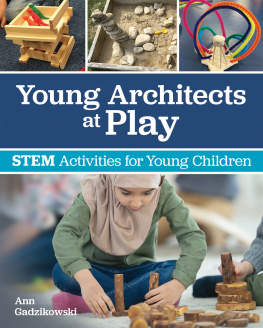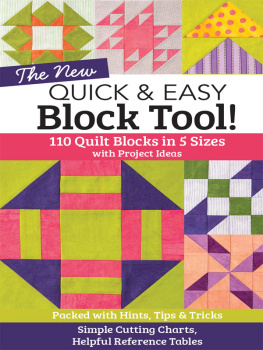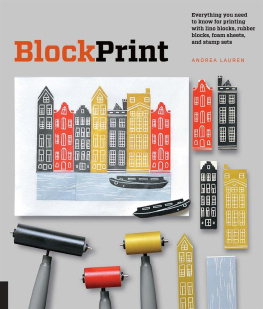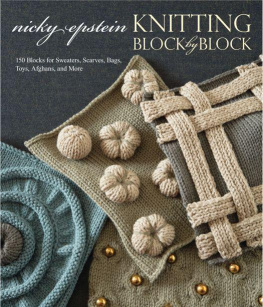Contents
Block Play
The Complete Guide to
Learning and Playing with Blocks
Sharon MacDonald
Illustrations: Katheryn Davis
Dedication
To my mother, Margaret Love Gary (1916-1999),
whose four daughters, Gloria, Shula, Dawn, and Sharon
were the building blocks of her life.
Copyright 2001 Sharon MacDonald
Published by Gryphon House, Inc.
PO Box 10, Lewisville, NC 27023
800.638.0928 (toll free); 877.638.7576 (fax)
Visit us on the web at www.gryphonhouse.com
All rights reserved. No part of this publication may be reproduced, stored in a retrieval system or transmitted in any form or by any means, electronic, mechanical, photocopying, recording or otherwise, without prior written permission of the publisher.
Reprinted June 2012
Library of Congress Cataloging-in-Publication Data
MacDonald, Sharon, 1942
Block play : the complete guide to learning and playing with blocks / Sharon MacDonald ; illustrations, Katheryn Davis.
p. cm.
Includes bibliographical references (p. ) and index.
ISBN 978-0-87659-253-3
1. Blocks (Toys) 2. Block building (Childrens activity) 3. Educational games. 4. Early childhood education Activity programs. I. Title: Complete guide to learning and playing with blocks. II. Title.
GV1218.B6M M33 2001
790.133dc21
2001023136
Illustrations: Katheryn Davis
Cover photograph: Straight Shots Product Photography, Ellicott City, Maryland.
Bulk purchase
Gryphon House books are available at special discount when purchased in bulk for special premiums and sales promotions as well as for fund-raising use. Special editions or book excerpts also can be created to specification. For details, contact the Director of Sales at the address above.
Disclaimer
The publisher and the authors cannot be held responsible for injury, mishap, or damages incurred during the use of or because of the activities in this book. The author recommends appropriate and reasonable supervision at all times based on the age and capability of each child.
Introduction (Or Learning Begins With Building Blocks)
This is a book about blocks, and what children can learn from building with them.
It is also a book about Robert, a young child who loved playing in the Block Center. Robert felt comfortable in the Block Center because his friends and family were there. (Well, not exactly, but we are getting ahead of ourselves.) The point is that Robert learned most of what he needed to know to be successful in school by playing in the Block Center. It was his favorite place when he was in my class in San Antonio, Texas.
Almost every class has a Robert, a child who has a hard time making the transition from home to school. During the first two weeks of school, Robert cried every morning when his mother left. To help Robert and the other children adjust to school, I asked each child to bring in a photograph of their family or friends. I made a Friends and Family Bulletin Board (or F and F Board), and the children hung their photos on it. Whenever a child felt lonesome for home, I would suggest that he or she look at the F and F Board for a while.
Robert brought in a photo of his family lined up on the front steps of his massive, two-story home. Other children brought in photos of their families inside their house, some eating dinner or blowing out birthday candles.
Robert visited his photo often.
After a few weeks, we needed the F and F Board for other things. The children were comfortable with the classroom by thenit had become part of their lives. We said good-bye to the photos of our friends and families, except for Robert. He was not yet ready to let go, so I found a spot for his photograph on a wall in the Block Center.
Although I did not realize it at the time, by choosing the Block Center wall for Roberts photograph, I had chosen Roberts center-of-play. When I passed out the center tags to the children each day, Robert always put his name in the Block Center, so he could be close to his home and family. Robert played there day after day, raking the blocks off the shelves, stacking them up, and spreading them out on the floor. He worked next to the other children, but not with themin parallel play.
Soon, I realized that Robert was not selecting other centers in the classroom. He would move to another center if I asked him to, but he was most comfortable in the Block Center. I became concerned. I wondered if he would be able to learn what he needed to be successful in school by playing only in the Block Center.
I decided to research the topic before deciding what to do. I read The Block Book by Hirsch (ed.) and The Complete Block Book by Provenzo (contributor) and Brett. I also read some helpful articles: Block Construction by Reifel in Young Children, November, 1984; What Block Play Can Do for Children by Brown and Briggs in Texas Child Care Quarterly, Spring, 1988; and, Blocks Are Not (circle all): Messy, Expensive, Difficult by Karges-Bone in Dimensions, Fall, 1991. These books and articles reassured me that blocks are a tool I could use to teach all of the skills and concepts necessary for children to be successful learners. Blocks work for all childrennot just Robert. I was delighted with what I found!
I learned that free play with blocks provides children with opportunities to develop many skills and concepts. Playing with blocks helps children learn in ways that are best suited to them. Blocks provide children with opportunities to be successful with the skills they have. To help children progress, observe what they do in the Block Center. Then, it is simply a matter of adding essential materials at the right time, a subject we will get into in detail later.
Children acquire skills such as sorting, matching, counting, sequencing, and learning shapes by playing with blocks. And in the process, they develop gross and fine motor skills. Through block play, children also observe physical properties, such as how force affects objects, and how structures react to force. The knowledge that children acquire is extended to other aspects of their lives. For example, they learn that unstable things fall down while stable things do not. Children learn that blocks have individual and group characteristics that are interrelated in complicated ways. By playing with blocks, children are acquiring the skills they need to be successful.
Chapter 1
Why Build with Blocks? (Or How Blocks Stack Up)
Why build with blocks? Good question! After all, with so many other things to do at school, why should children stack blocks and push them around on the floor? What do children learn, anyway?
Through block play, children can learn to read, write, speak, and listen. Block play can teach them about math, science, and social studies. Block play often involves cooperative, collaborative learning, which helps children grow emotionally and socially. Block play also enhances their physical growth and development.
The early childhood curriculum topics and skills that children learn through block play are shown collectively in the illustrations on the following pages.
See the Math in the unit blocks.
See the Science in the y-switch block.
See the Art in the constructions with cylinders.
See the Literacy and Language Arts in the unit blocks.
See the Physical Development in the bridge construction.
See the Social Studies in the unit blocks.








